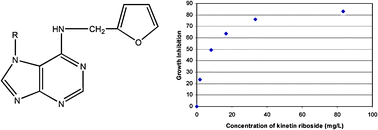Inhibitory effect of kinetin riboside in human heptamoa, HepG2
Abstract
Cytokinins ribosides such as

* Corresponding authors
a Applied Science School, Temasek Polytechnic, 21 Tampinese Avenue 1, Singapore, Republic of Singapore
b Natural Sciences and Science Education Academic Group, Nanyang Technological University, 1 Nanyang Walk, Singapore, Singapore
c
Department of Community, Occupational and Family Medicine, National University of Singapore, 16, Medical Drive, Singapore
E-mail:
cofoes@nus.edu.sg
Cytokinins ribosides such as

 Please wait while we load your content...
Something went wrong. Try again?
Please wait while we load your content...
Something went wrong. Try again?
J. Cheong, D. Goh, J. Wan Hong Yong, S. Ngin Tan and E. Shi Ong, Mol. BioSyst., 2009, 5, 91 DOI: 10.1039/B712807J
To request permission to reproduce material from this article, please go to the Copyright Clearance Center request page.
If you are an author contributing to an RSC publication, you do not need to request permission provided correct acknowledgement is given.
If you are the author of this article, you do not need to request permission to reproduce figures and diagrams provided correct acknowledgement is given. If you want to reproduce the whole article in a third-party publication (excluding your thesis/dissertation for which permission is not required) please go to the Copyright Clearance Center request page.
Read more about how to correctly acknowledge RSC content.
 Fetching data from CrossRef.
Fetching data from CrossRef.
This may take some time to load.
Loading related content
